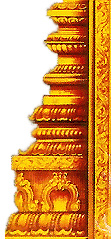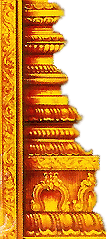|
|
Home >>
Other Temples >
sri Neer Katha Aiyyanar temple
|
| |
- Details
- Path
- Map
- Photos
- Near By Temple
| |
| Sri Neer Katha Aiyyanar temple |
|
| |
|
![[Image1]](http://img1.dinamalar.com/Kovilimages/T_500_816.jpg)
|
| | |
| | | |
|
|
|
Moolavar | : |
Neer Katha Aiyanar |
|
|
Urchavar | : |
- | |
|
Amman / Thayar | : |
Poorna, Pushkala | |
|
Thala Virutcham | : |
- | |
|
Theertham | : |
- | |
|
Agamam / Pooja | : |
- | |
|
Old year | : |
500-1000 years old | |
|
Historical Name | : |
- | |
|
City | : |
Rajapalayam | |
|
District | : |
Virudhunagar
| |
|
State | : |
Tamil Nadu |
| |
|
|
| |
|
|
 | Singers: |  |
| |
|
|
| |
- |
|
| |
|
|
 |
Festival: |
 |
| |
|
|
| |
Chithirai first day (falling almost on April 14) and Chithirai Thiruvizha (April-May) are the festival days in the temple. |
|
| |
|
|
 |
Temple's Speciality: |
 |
| |
|
|
| |
Graceful Neer Katha Aiyanar temple is situated at the foothills of Western Ghats where two rivers, Palaru and Neeraru meet. On the left of Aiyanar is Pushkala and Poorna on the right. |
|
| |
|
|
 |
Opening Time: |  |
| | | | | |
The temple is open from 6.00 a.m. to 5.00 p.m. |
|
| | | |
 |
Address: |  |
| | | | | |
Sri Neer Katha Aiyanar Temple, Rajapalayam, Virudhunagar district. |
|
| | | |
 |
Phone: |  |
| | | |
| |
- | |
|
| | |
 |
General Information: |  |
| |
|
|
| |
Since very ancient days, Tamil people use to worship deities of heroism. Aiyanar is one among them. It is the stanch faith of the people that Aiyanar goes around places on His horse to protect people from evil powers. Aiyanar is considered as the main deity of deities in rural places. The letter “I” in Tamil represents leadership, beauty, wonder, king, guide, God, father etc. |
|
| |
|
|
 |
Prayers |  | |
|
| | | |
Devotees approach Aiyanar for solutions for various problems in their families. | | |
|
| |  |
Thanks giving: |  | |
|
| | | |
Realizing their expectations, devotees perform abishek to Aiyanar, feed the poor and contribute what they could to the temple. | | | |
| |  |
Greatness Of Temple: |  |
| |
|
|
| |
Neer Katha Aiyanar is the source of all power to ensure the industrial growth and agricultural fertility of Rajapalayam town. Aiyanar is everything for the people here in their daily life.
Vanalingam, Thalamaiswami, Perumal, Lakshmi, Chinna Ottakarasamy, Peria Ottakarasamy, Vanakali, Madam, Madathi, Rakachi Amman, Vanapechiamman, Karuppusamy, Dharmaraja, Sapthkannis have their shrines in the temples gracing the devotees.
Two men, Chinna Ottakaran and Peria Ottakaran came to Rajapalayam for selecting wood for the flag post of Madurai Meenakshi Amman. They found that some trees under the control of Aiyanar suitable for their purpose and began to axe them. While doing so, they found blood from the tree and were terror-struck. They pleaded with Aiyanar of their innocence and said that they axed the tree only for making the flag post for Meenakshi Temple. Graceful Aiyanar pardoned them and asked them to return back after delivering the wood and be His security.
Mother Meenakshi stopped them from going back. Exasperated Aiyanar made all people sick. Mother called the two Ottakarans and allowed them to go back to Aiyanar and promised that she would come and meet them once in a year with three garlands. Chinna Ottakaran and Peria Ottakaran are the securities even today for Aiyanar. |
|
| |
|
|
 |
Temple History: |  |
| |
|
|
| |
Though Aiyanar worship is in vogue in Tamilnadu from days of yore, building temples for Him began from the 10th century by Chola King Rajaraja I, followed by other Aiyanar Temples in other parts of the state. Rajapalayam Neer Katha Aiyanar temple also came into being during this period only.
The western border of the Pandya region where the temple stands was once usurped by Pandala king of Kerala. Pandya sent an army headed by Chinniah Thevan who travelled through Srivilliputhur and Rajapalayam, reached the western ghats, and drove the Kerala king and his army and recovered the territory.
While they were returning back to Pandya kingdom, they were caught by floods in the river. They prayed to Aiyanar to save them. A large tree fell across the tree which, as a bridge helped the soldiers to cross the river. Thus, Aiyanar came to be known as Neer (water – flood in this context), Katha (protecting) Aiyanar. |
|
| |
|
|
 |
Special Features: |  |
| |
|
|
| |
|
|
| |
|
|
|
| |
|
|
|
|
| | Location :
Rajapalayam is connected with bus from all places. Government and mini bus facilities are available to Neer Katha Aiyanar Temple.
Near By Railway Station :
Rajapalayam
Near By Airport :
Madurai
Accomodation :
Rajapalayam:
Hotel Asoka: +91-4563-222 486, 221 348
Hotel Ananda: +91-4563-230 501-5line, box +91-4563-222 232
Hotel Jai Shantham: 91-4563-220 302, 221 310
| |
|
 |
|
|
|
|
|





